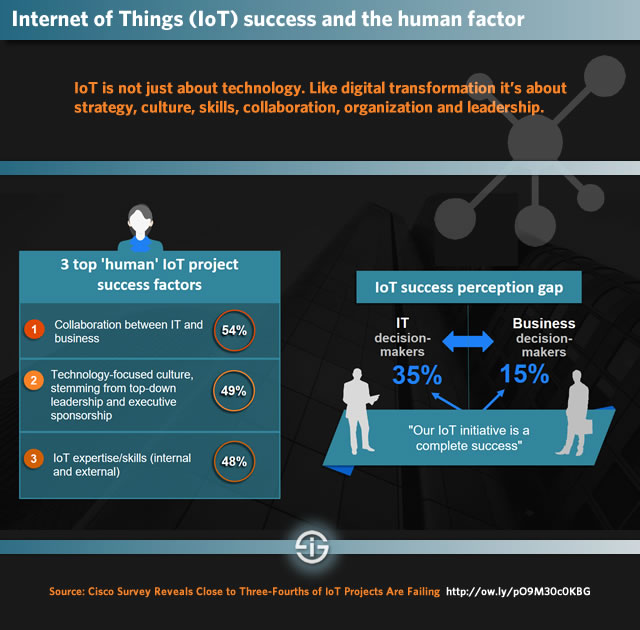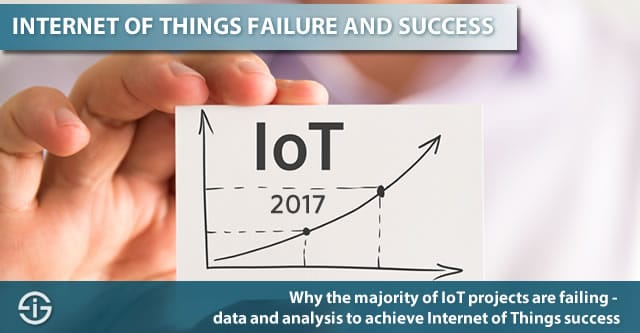After a break in 2016, Cisco organized another edition of its Internet of Things World Forum from May 22nd to May 24th 2017 in London.
At the occasion of that IoT World Forum 2017 the company also released data from a survey which looked at the success and failure rate of Internet of Things projects and initiatives, as well as the conditions for IoT success in times that IoT is increasingly present in the digital transformation strategy journeys of ample organizations.
Despite the clear growth of mainly Industrial Internet of Things deployments and the staggering predicted growth of Internet of Things endpoints, the Cisco survey found that the majority of IoT projects are failing.
Successful and unsuccessful IoT projects: the stats
Before looking at the why some data:
- 60 percent of IoT initiatives stall at the Proof of Concept or PoC stage. That is a lot. Yet, it shouldn’t come as a surprise as you’ll read below.
- 26 percent of the surveyed companies consider their Internet of Things deployments and initiatives as being successful.
- While 35 percent of surveyed IT executives state that their IoT project was a complete success, only 15 percent of business executives considered the same. Yes, indeed, yet another perception gap but how else could it be?
- Overall nearly three-fourths of Internet of Things initiatives are considered a failure, while a third of all projects being completed were not seen as a success.
While it’s important to understand why IoT projects succeed by looking at the business (again, the business) essence of existing Internet of Things examples, it’s equally important to understand why many IoT implementations fail or never leave the Proof of Concept stage. And do go out of your specific industry to do so as the benefits organizations try to achieve with the Internet of Things in the end are relatively universal.
It’s also key to draw lessons from IoT failures internally. And that’s what respondents fortunately seem to do: 64 percent of respondents stated that their investments in IoT projects have accelerated thanks to learning from stalled and failed IoT initiatives.
Beyond the data and stats: the pretty universal reasons why IoT projects succeed or fail
The high failure rate of IoT projects will probably be the major focus of many headlines looking at the research.
However, if you start looking at the reasons, Cisco’s findings shouldn’t come too much as a surprise. While Cisco, for all the obvious reasons, advises to work with an IoT partner ecosystem for your Internet of Things projects, from start to finish (and you should indeed), there are few surprises in the research.
Alignment between key stakeholders: the challenge of all digital transformation
As a matter of fact the reasons for IoT project failure are very similar to the reasons why digital transformation initiatives and so many other projects fail, whether it concerns Industry 4.0 initiatives, innovation projects or digitalization exercises.
The mentioned gap between perceptions of IT executives and business executives is already one indicator. It’s pretty obvious that, if there is no alignment on what makes a successful IoT project successful, failure is the consequence. We see exactly the same in digital transformation, information management projects, you name it.
The eternal challenge of overlooking the human dimension
Cisco’s research found that three out of the four main factors behind successful Internet of Things projects, are related with human factors, people and relationships.
Given the previous point it’s not a surprise that collaboration between IT and the business side was mentioned as the main factor of success and cited by 54 percent.
Just think about it or better: reverse that finding. It means that many IoT projects fail because of a lack of collaboration between IT and the business side. On top of the fact that it’s so sad to see this happening over and over, also in digital transformation indeed, this isn’t even a matter of IoT project failure, it’s a token of a broader failure. If there is no business case, strategy and collaboration with clear outcomes, there is no Internet of Things project that can succeed.
And, yes, overlooking the human element is a major reason of digital transformation failure too.

The difference of Internet of Things technologies and needed strategic steps for IoT success
Moreover, it’s a well-known fact that 1) we still focus a lot on Internet of Things technologies, 2) these technologies are not exactly what traditional IT teams thoroughly know and 3) for an outcome-oriented strategic mandate executive buy-in is key.
And what do we see? IoT expertise was mentioned by 48 percent of respondents as being important for success and leadership and executive sponsorship with a technology-focused culture is cited by 49 percent of respondents (whereby we hope that technology-focused means focused on clear business cases, inspired and enabled by a culture of technological optimization, innovation and collaboration).
The role of an experienced IoT partner ecosystem in a holistic approach
It’s clear that for many it’s still early days and mistakes are made. Yet, a lot of them are more related with maturity, skills and culture than anything else.
The complexity of IoT projects is underestimated, the Cisco report says; it looks easy on paper. So, yes the right partnerships are key too as many skills simply are not available in-house and a partner ecosystem with experience by definition adds to the various capabilities which are required for IoT success.
This is also the case for the strategic dimension.
A work in progress: IoT maturity and the surface
Despite the messaging about failure of IoT projects, companies are positive about the potential of IoT and plan to do more.
As a matter of fact, 61 percent believe they have barely begun to scratch the surface of what the Internet of Things can do for their business as you can read in the SlideShare below, even if organizations are moving to scalable IoT deployments.
Replace Internet of Things by numerous other technologies and evolutions, whether it concerns Industry 4.0, additive manufacturing, predictive analytics or robotics, to name a few, and you’ll find similar results.
In fact, replace the Internet of Things by digital transformation and look at the maturity levels and goals of most organizations and you’ll see the majority is only scratching the surface too.
Further details in the SlideShare presentation and in the press release. More about Cisco’s IoT World Forum 2017 here.
Top image: Shutterstock – Copyright: Constantin Stanciu – All other images are the property of their respective mentioned owners.


